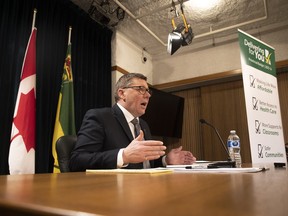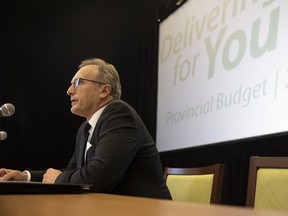“If the tariffs are on for an extended period of time, it’ll push us into a deficit position. It’s difficult to deal with the uncertainty.”
Article content
Concerns over U.S. and Chinese tariffs could keep Saskatchewan’s new finance minister up at night as the province forecasts a thin surplus of $12.2 million for the next fiscal year.
Article content
Article content
“This budget is being presented at a time of incredible uncertainty caused by the words and actions of the president of the United States,” Minister Jim Reiter said Wednesday as he presented Saskatchewan’s 2025-26 budget at the legislature.
Advertisement 2
Article content
“It was not possible to build the exact impact of the tariffs into the budget.”
Reiter said the province has been “prudent” and “realistic” in its plans while eschewing the idea of “borrowing” money for a contingency fund, which Reiter said he considered.
Recently, Alberta earmarked $4 billion for its contingency fund while New Brunswick opted for $50 million and British Columbia $4 billion.
“It’s a balanced budget,” said Saskatchewan Premier Scott Moe, noting that he feels the budget puts Saskatchewan in a “tremendous position of strength.”
Moe added that a contingency fund against tariffs would require “deficit” funding, which did not interest the government.
“We made the decision not to build in an arbitrary contingency fund that will not have a direct connection to the situation by the time the budget is delivered,” reads the budget.

NDP Leader Carla Beck called the budget a “work of fiction,” saying “it pretends as if the last three months haven’t even happened.” She said there are no measures contained within “to protect workers, producers, business and industry from tariffs.”
Article content
Advertisement 3
Article content
Moe acknowledged there was considerable uncertainty and risk while his finance minister put an even finer point on it.
“If the tariffs are on for an extended period of time, it’ll push us into a deficit position,” said Reiter. “It’s difficult to deal with the uncertainty.”
Amid Canada’s trade war with U.S. President Donald Trump, retaliatory Chinese tariffs of 100 per cent on canola oil, meal and peas are set to come into force on March 20. Those tariffs are a response to Canada imposing its own levies on Chinese-made electric vehicles, aluminum and steel.
Moe said he would like to see Canada drop its tariffs against China as levies on canola exports would represent “the most immediate, most impactful tariff that we have felt in this province.”
The assumption made during budget planning was that the tariff situation with the U.S. would return to a near-normal state by April 1, 2025. But the province did chart out a worst-case scenario for a year-long trade war that includes U.S. tariffs of 10 per cent on energy and 25 per cent on all other products, in addition to Canadian counter-tariffs.
Advertisement 4
Article content
Budget documents lay out scenarios in the face of tariffs where Saskatchewan could see an $8.2-billion reduction of exports from the province to the U.S. — a decrease of real GDP by up to $4.9 billion (or 5.8 per cent) and a $1.4-billion reduction in revenue.
With potential economic headwinds, there is also the issue of debt, which is expected to rise to $38.3 billion by spring 2026. This year alone the province anticipates it will spend $1.1 billion — or five per cent of total expenses — just to pay down the interest on the current debt.
“It’s irresponsible,” said Gage Haubrich of the Canadian Taxpayers Federation. “That’s a huge amount of money that should be used for tax relief. It should be used for services.”
The government plans to spend $21 billion in 2025-26, with projected revenues coming in slightly above $21 billion. The province is banking on a rising population, growing oil and uranium resource revenues, and stable potash markets to see Saskatchewan through this round of economic tumult.
The government touts a spending increase compared to what was budgeted a year ago, but the NDP says this budget comes with a decrease to health and education funding.
Advertisement 5
Article content
Long before the current trade wars and reciprocal actions against the U.S., mid-year financials in November projected the provincial deficit would balloon to $743.5 million from the $273.2-million shortfall forecast in the 2024-25 budget. A third-quarter update also delivered on Wednesday showed the deficit is now expected to be $660.6 million.
Health, agriculture, protection of persons and property, and socials services drove up expenses while corporate income tax, the Saskatchewan Auto Fund and the Workers’ Compensation Board contributed to higher than expected revenue.
Wednesday’s budget announcement also signals the resumption of the first session of the 30th legislature, with MLAs sitting for the next 30 days. The session began with a 10-day sitting late in 2024 after the provincial election.
The Regina Leader-Post has created an Afternoon Headlines newsletter that can be delivered daily to your inbox so you are up to date with the most vital news of the day. Click here to subscribe.
With some online platforms blocking access to the journalism upon which you depend, our website is your destination for up-to-the-minute news, so make sure to bookmark leaderpost.com and sign up for our newsletters so we can keep you informed. Click here to subscribe.
Article content



